Do you ever try to start your creative engine and feel like you are met with the mental equivalent of sputters, grinding gears, and high pitched screeching?
Do you ever begin a project eagerly, only to find yourself saying “there is no way I’ll ever be able to accomplish my goals”?
Do these types of overwhelm ever bring you to the point where you feel physically anxious, find your eyes welling up, or turn to negative self talk as a way to cope?
Then keep reading, because this week’s post is for us.
I needed a better way to handle overwhelm.
Last week I had an utterly overwhelming writing session. I know the topic I’m writing about extremely well (my dissertation research), but because I’m applying a theory that is relatively new to me, I feel totally out of my comfort zone.
Even though I’m aware of my personal strengths as a writer and as a productivity researcher, I found myself feeling wholly incapable of starting this project. My confusion about how to proceed transformed into an overwhelming panic.
I knew three things:
- What I was doing was not working.
- I felt horrible.
- I needed to find a better way to approach this project.
So, I developed a process that I’m calling Four Steps to Handle Overwhelm.
Although I’ll be sharing my experience with handling my own overwhelm in terms of writing, the takeaways are applicable to any new creation. I’ll break it down step by step, guiding you through the process. At the end of the post, I’ll share a template you can adapt to your own experience, which will help you to navigate your own overwhelm.
Step 1: Identify The Overwhelm
I know that I’m a good researcher and writer, so I didn’t understand why I couldn’t just write the damn paper. In an attempt to identify why I was so overwhelmed, I stopped and checked in on what I was actually trying to accomplish. The paper I was attempting to write is the capstone for a Graduate Feminist Certificate. I want my end result to meet multiple scholarly criteria, to impress my committee, and to be 25 pages. However, I also want to use this paper as a part of my third dissertation chapter and as a conference paper next March.
Those are three different projects, but I was treating them like one, which means I was overwhelmed with imagining three different end results. Once I identified this, I was able to feel a bit more aware of what was causing my overwhelm.
To Do: Note all of the goals you have for this project. You may notice that you have set yourself up for quite an insurmountable task and you may later decide to scale back on your project. Right now, do not try to come up with any game plans or solutions; the point is to identify what and how many goals you have attached to project. Below is my Step 1 example.

Step 2: Name Your Reactions
You have now identified the scope and goals for your project. Good! If you’re like me, you may notice that you were aiming to do too many things at once. Now, it’s time to identify how you are feeling—physically and emotionally—so you can find out how to calm your mind and body. This step is important for getting you back to a place where you can can write or create again, because, as I mention in my Emotional Agency post, “the key is to recognize that your perception is off, that your body and mind are responding in ways that are not appropriate to the level of threat in the current situation, and then to calm yourself down to get back to your window of tolerance.”
To Do: Check in with your body and mind and actually name how you feel. You might feel a mixture of fight or flight feelings, but try to identify how you feel both physically and emotionally. You can use an emotions wheel like this one by Geoffrey Roberts as a guide:
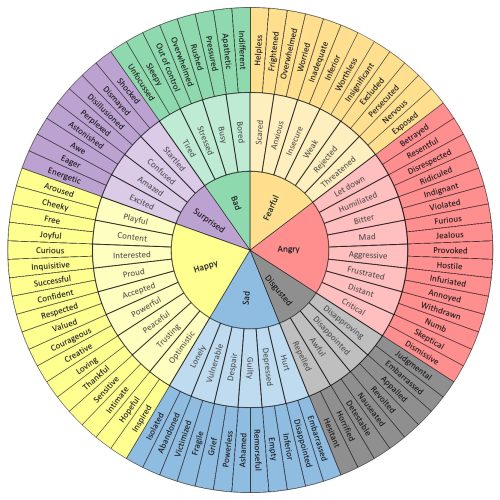
(Image: “Emotions Wheel”)
Below is my Step 2 example.
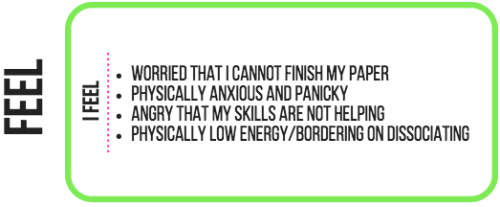
Step 3: Calm Your Mind and Body
You have now identified the project that is overwhelming you and named your physical and emotional reactions to your overwhelm. Nice work! The next step is to calm your body and mind, bringing yourself back to your window of tolerance through practical actions.
To Do: Take a step away from your project to focus exclusively on calming your mind and body through intentional acts like meditation, talking out your overwhelm with a friend or writing in a journal, going for a walk, or other calming practices. My Negative Self Talk post includes instructions for calming your mind and body through breathing timers, Emotional Freedom Technique (E.F.T. or tapping), journaling, and mantras. If you experience PTSD and flashbacks, my linked post also includes steps on managing flashbacks.
If you still feel acute anxiety or overwhelm, you should continue working with step 3 before you move on to step 4. You may need to take a bit of space or time away from your project to regulate your mind and body. You deserve to feel calmer before you dive back into work!
Below is my Step 3 Example.
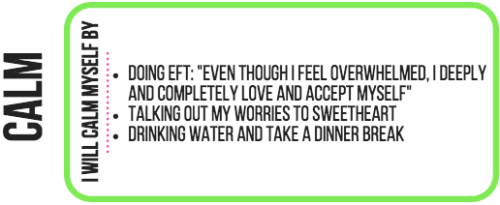
Step 4: Prompt Small Tasks
You have now identified your project, named your reactions, and calmed your mind and body. Really good job!
After I had identified my feelings of worry, anxiety, anger, and physical tiredness, I decided to take the rest of the night off and worked to calm myself with E.F.T., drinking water, eating dinner, and taking a bath. When I was able to talk to my Sweetheart later that night, I found myself tearing up when I described how challenging my writing overwhelm had felt.
Regular readers of The Tending Year know that my Sweetie offers me phenomenal suggestions. Although she isn’t a self development or productivity researcher like me, she gifts me with good ideas that can only come from the combo of a Gemini brain with an art school background and the practical skill set of a business consultant (her job is actually much more cool and complex, but that short title will suffice here). She suggested that I try reseeing my writing practice like painting.
Using Painting as a Metaphor for Writing
She told me that when you begin a painting, you start with a paint wash of the canvas, then you add swaths of color, then you begin to develop sections. You likely will not be able to tell at first what is going to happen (she said “you don’t just sit down and draw a perfect eyeball in detail at the beginning,” which I found to be a memorable mantra).
I immediately saw the connection between what she was describing and my goals as a writer. Any remaining sense of physical and emotional overwhelm was calmed in me. The broad wash and plotting of background colors? This would be a loose outline and a general draft of my thesis, plotting ideas in different places, mapping out the questions I came up with as I wrote. I would start broad and slowly hone my use the the theory that had overwhelmed me at the beginning. I felt confident, and wrote small prompts for myself to start on the next day.
To Do: Write out specific small prompts that you can use to approach your paper from a broad perspective. Do not concern yourself with answering any questions or filling in any blanks yet—instead, write down questions you can explore when you are ready to dive back in. Feel free to use the ones I note in my Step 4 Example below.
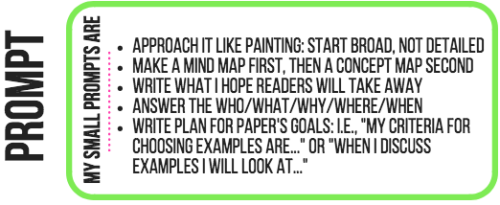
Interested in reading more about how to approach writing like painting? Check out these blog posts: “Comparing Writing to Painting” by Rudy Rucker, “Want to Learn How to Write? Study Painting” by Joe Bunting, and “Write Like a Painter” by Veronica Rossi.

Want A Printable Version of the Four Boxes for Handling Overwhelm Process?
Here you go! Send me an email at [email protected] if you’d like a PDF version!
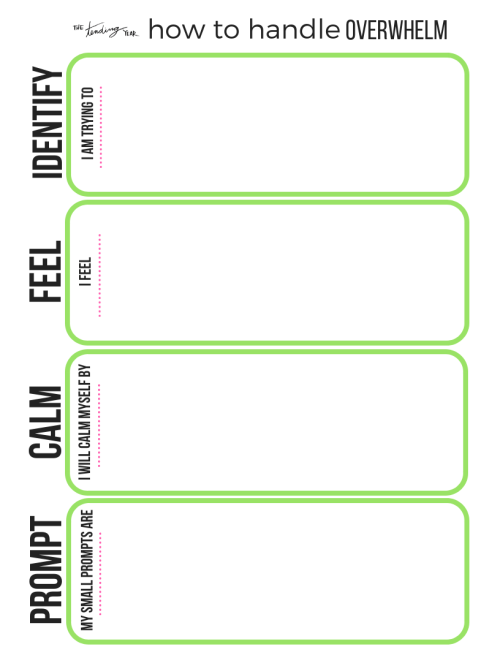
*Please note that the original version of this blog post was published here.
newsletter and free resources
Sign up below to access six free resources and my newsletter, tending.

